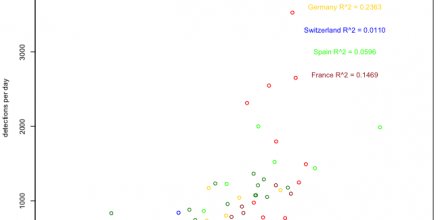We selected 21 countries from 5 continents and all global climate zones, with a total of 103'814 cases of diagnosed Coronavirus (COVID-19) detection (infections), and analysed the correlation of new infections with 6 major weather variables (air temperature , relative humidity, radiation, wind speed, sunshine hours and precipitation) during the period from 01.January to 18.March 2020, using our hourly history+ data, which can be readily downloaded for any place on Earth.
The study produced no visible correlations for any of the variables, neither in 21 countries from 5 continents and all global climate zones, nor within the 7 countries with most detections in March (China, Italy, Spain, France, Germany, Switzerland, Iran).
Although this study is preliminary, some important conclusions seem possible:
- Higher air temperatures are unlikely to slow the spread of the virus significantly.
- The COVID-19 infections seem to be largely independent of external weather influence.
- Further analysis should focus on the effect of temperature, relative humidity and radiation, by reducing masking factors such as behaviours changes (public restrictions, hygiene measures, others), location differences and reporting imprecision.
As a general summary, we conclude that containment of COVID-19 infections can not rely on weather as a significant factor in helping reduce the spread of the disease. The detailed study is available for download here.
We will continue investigations into more detailed relations, and appreciate any contributions and suggestions.




